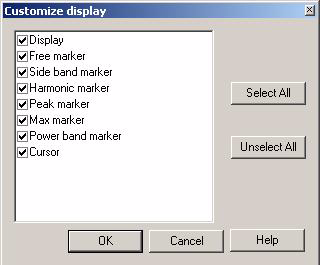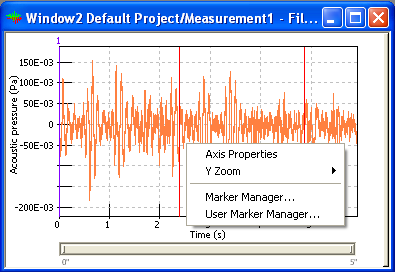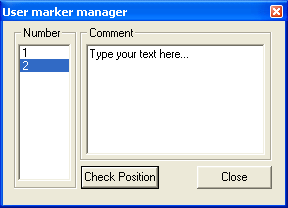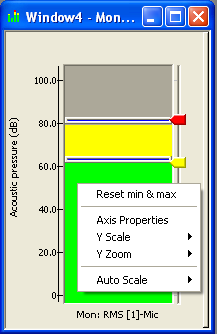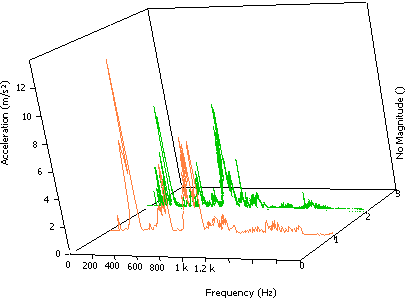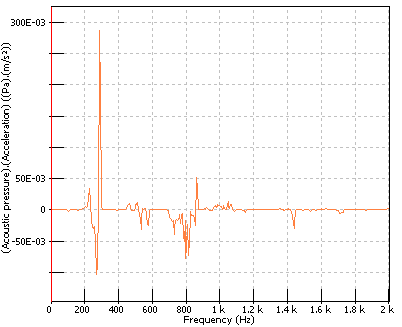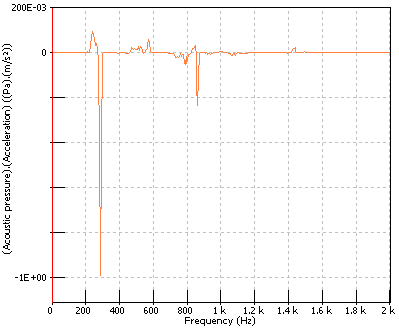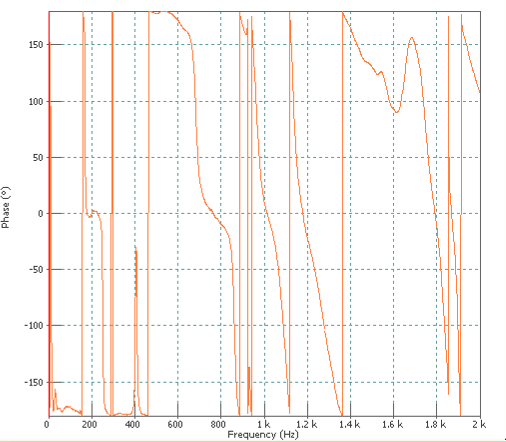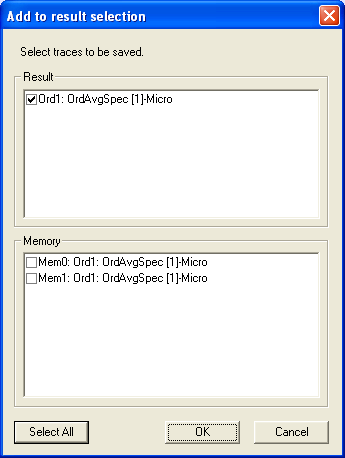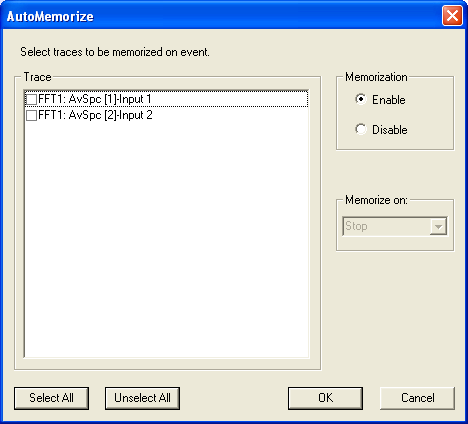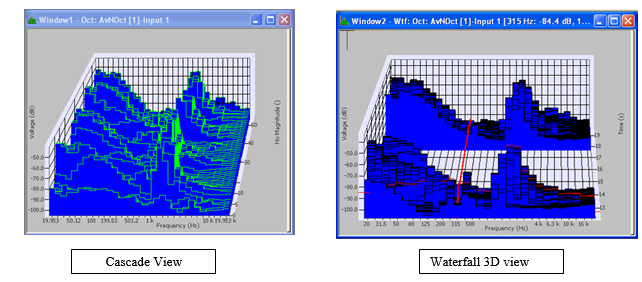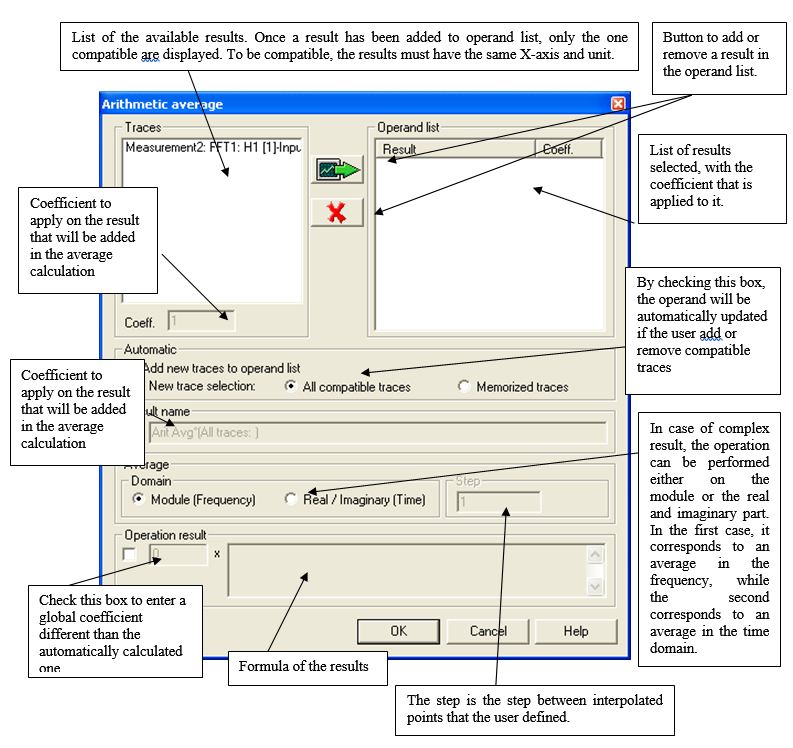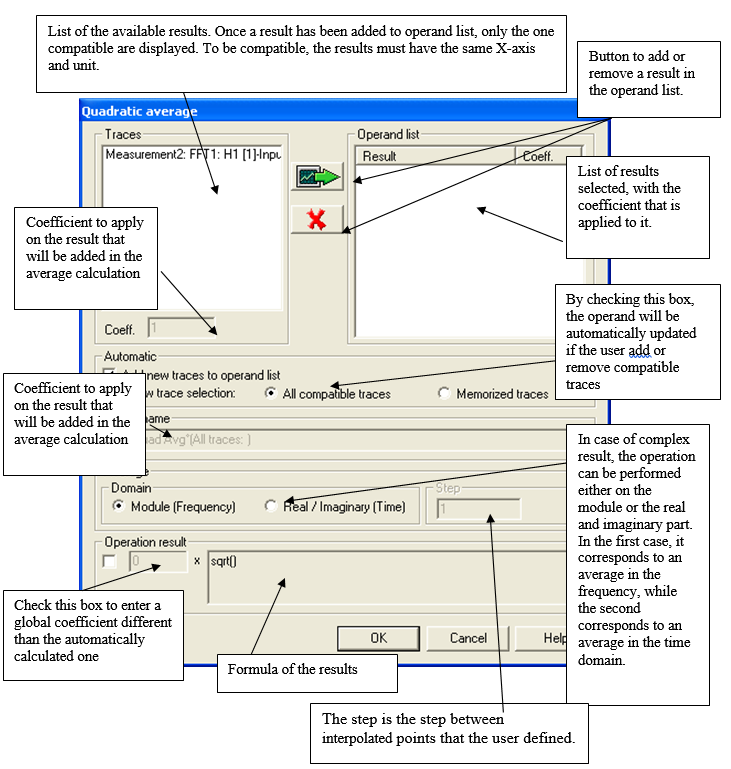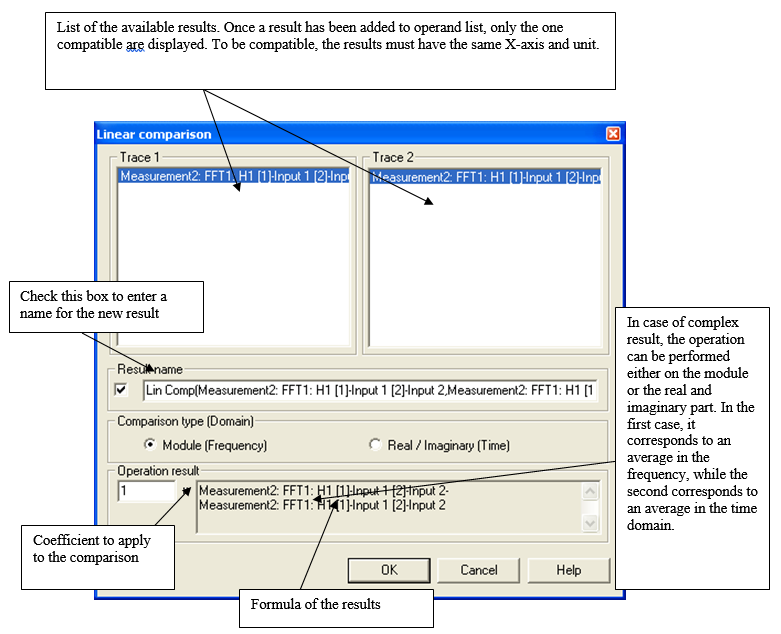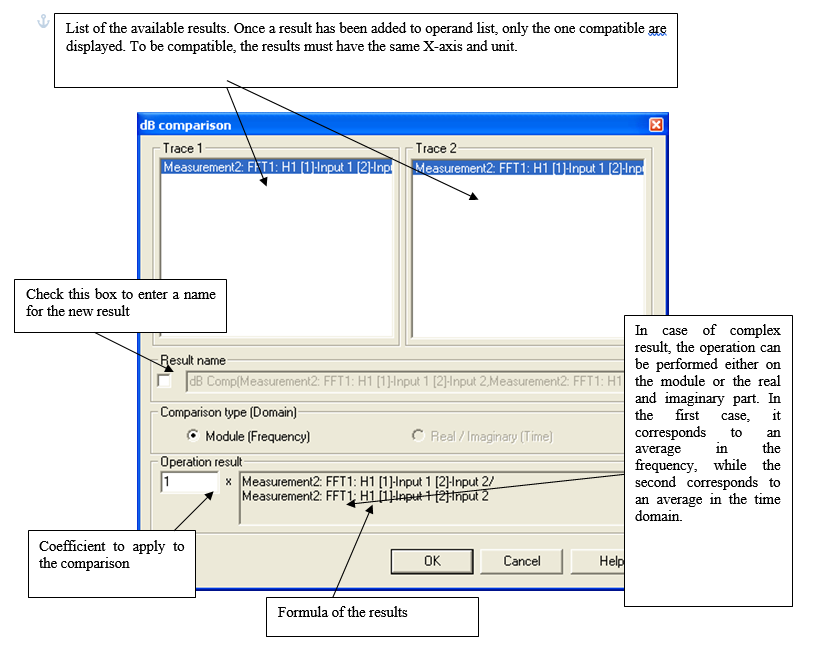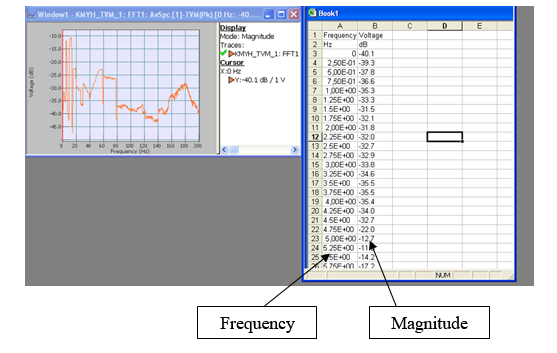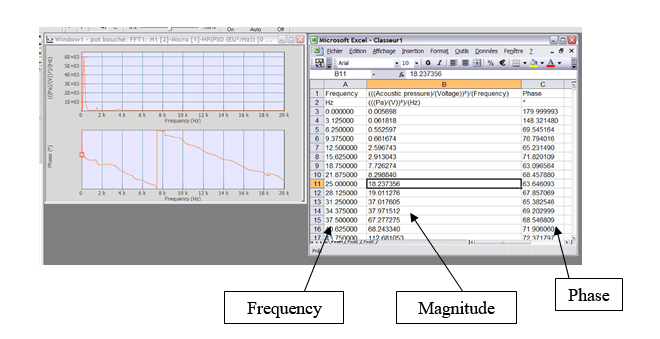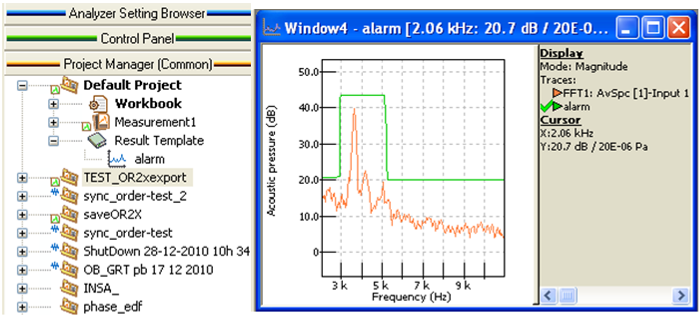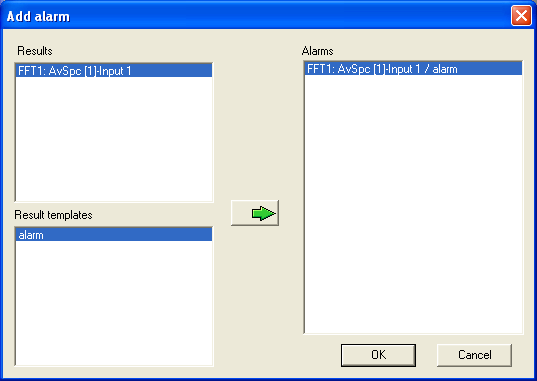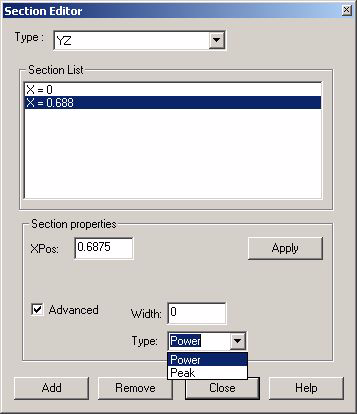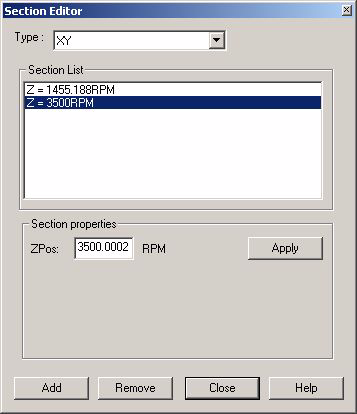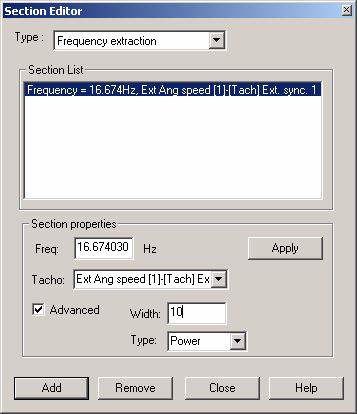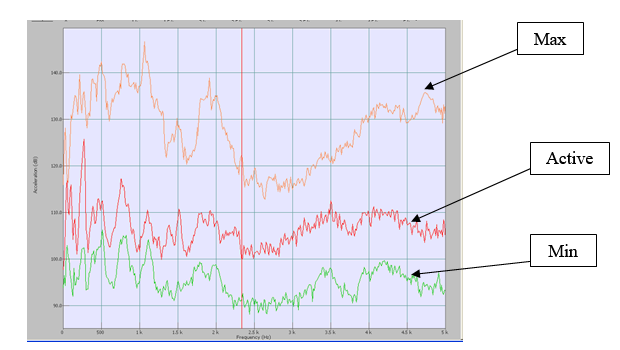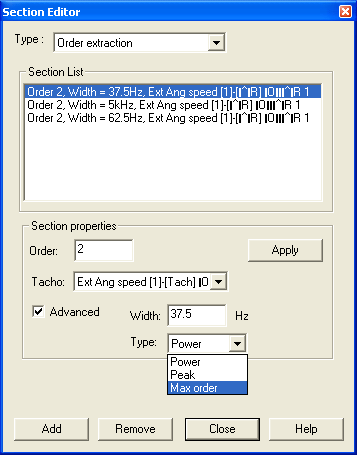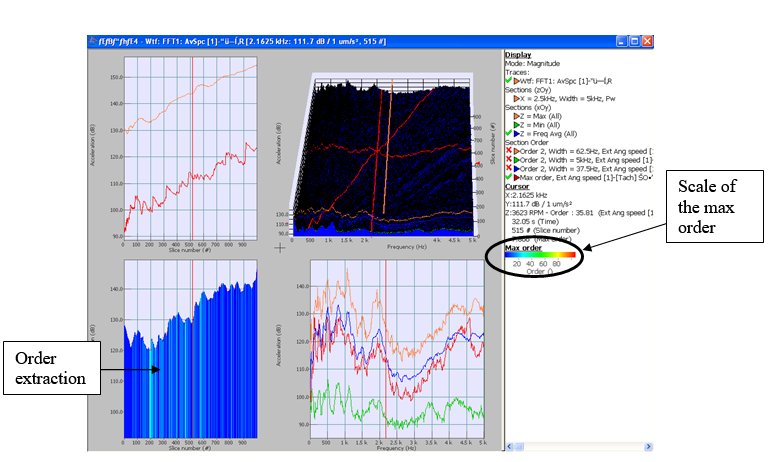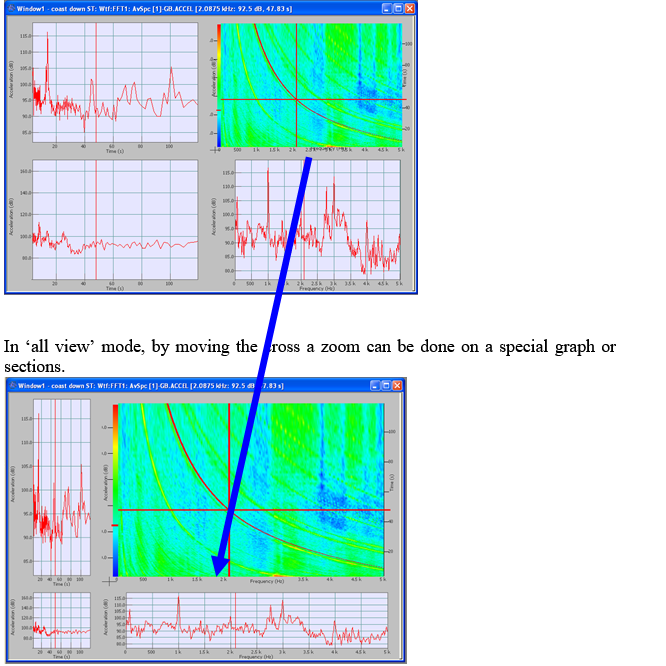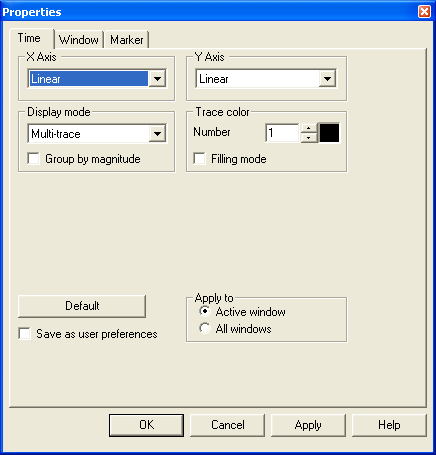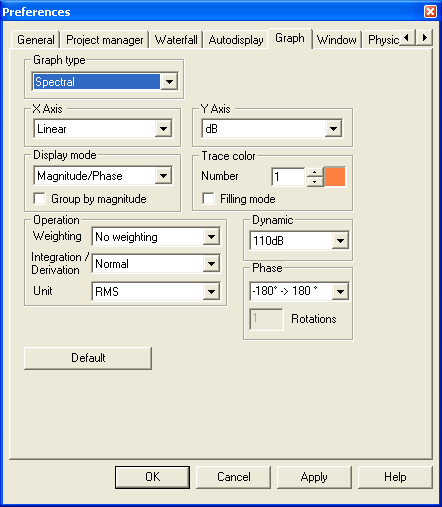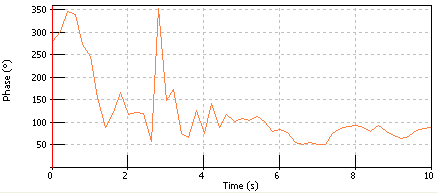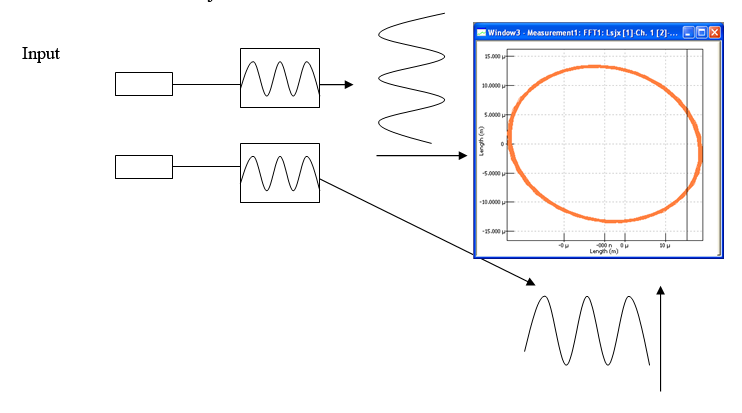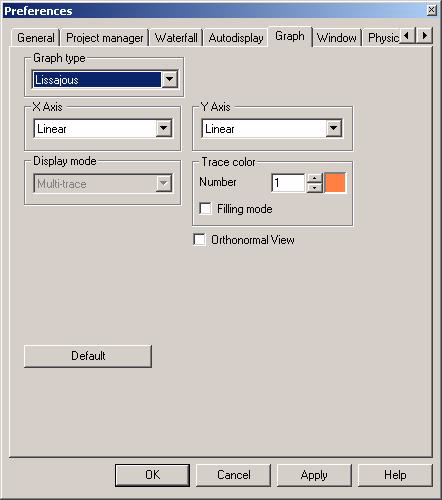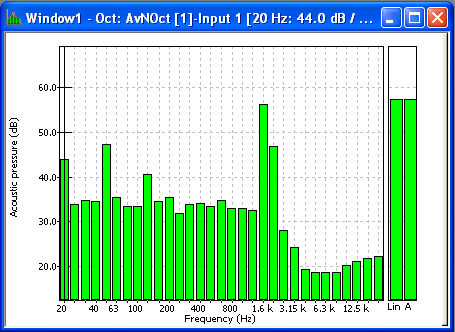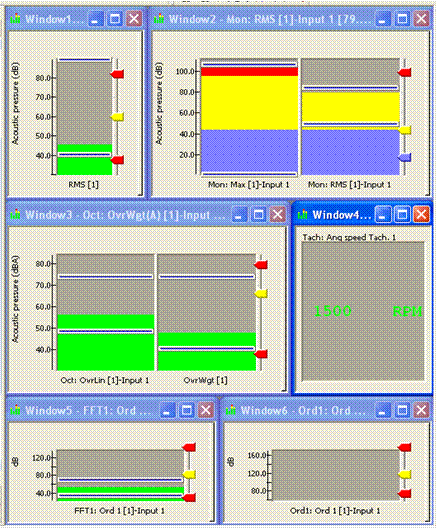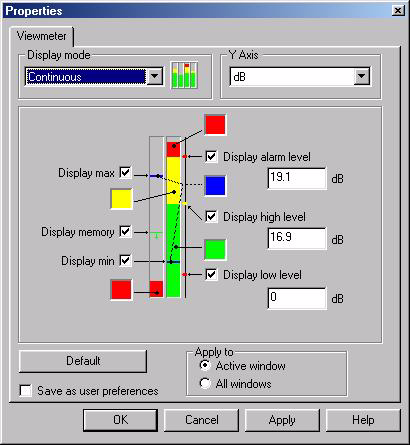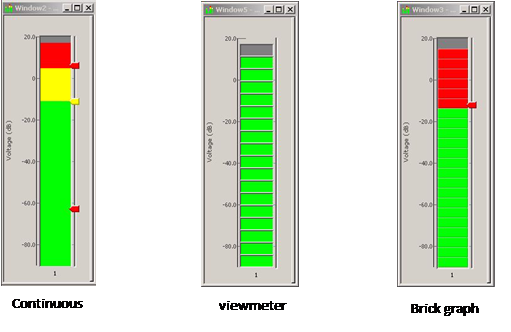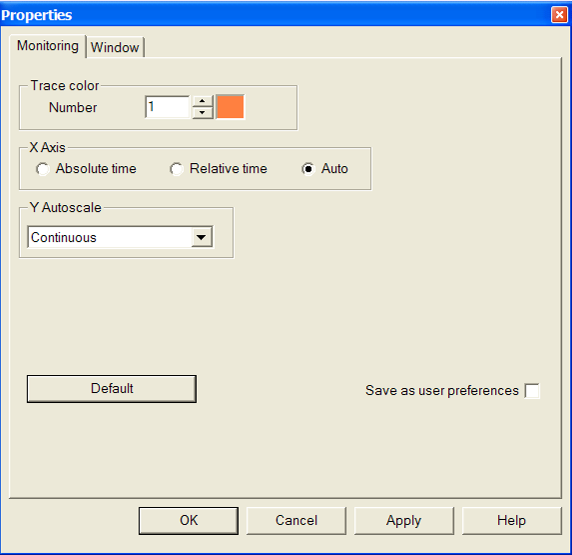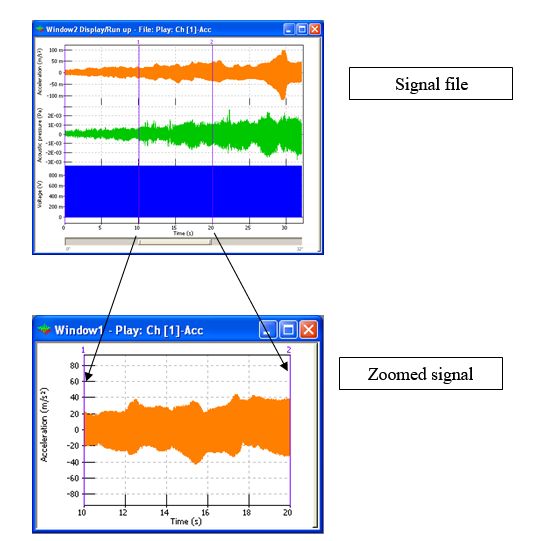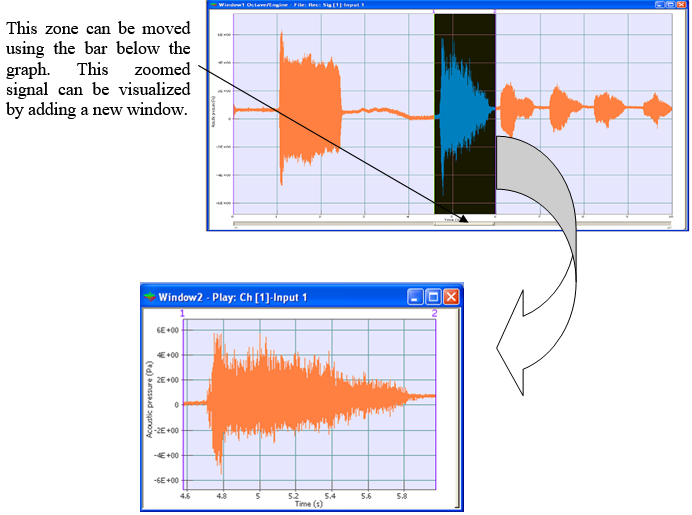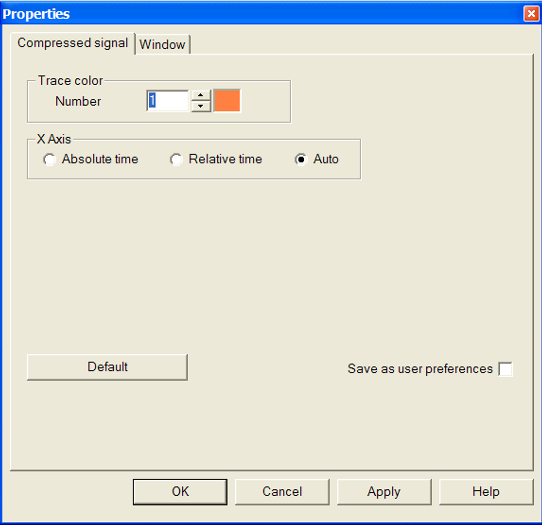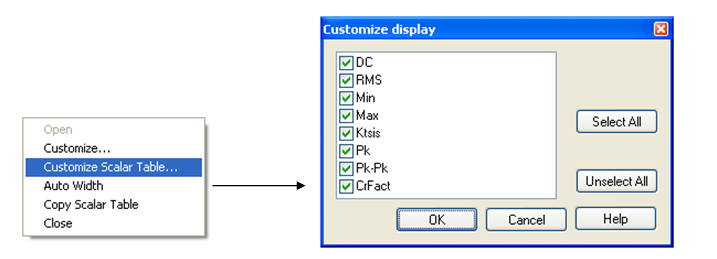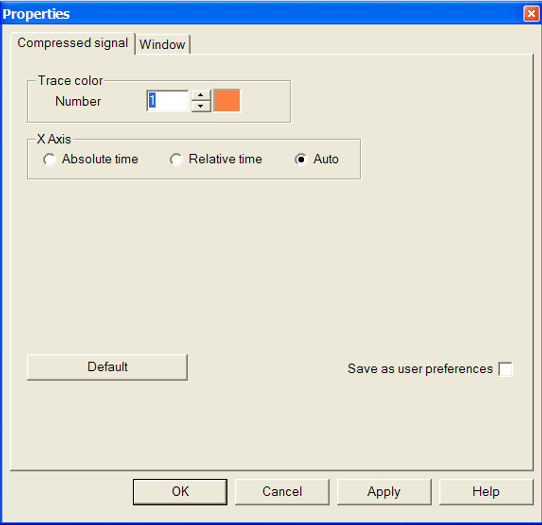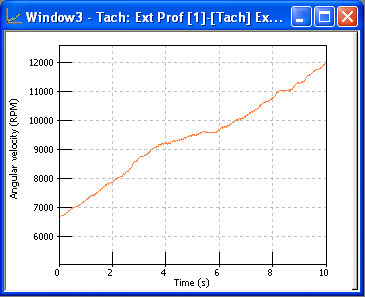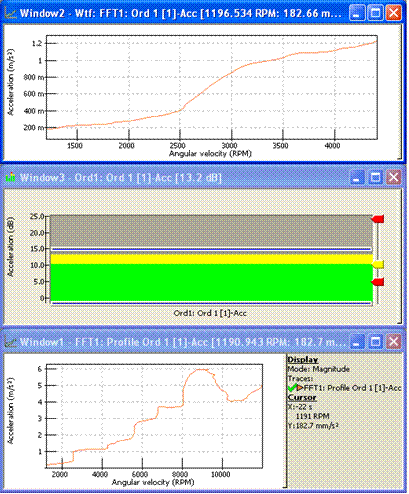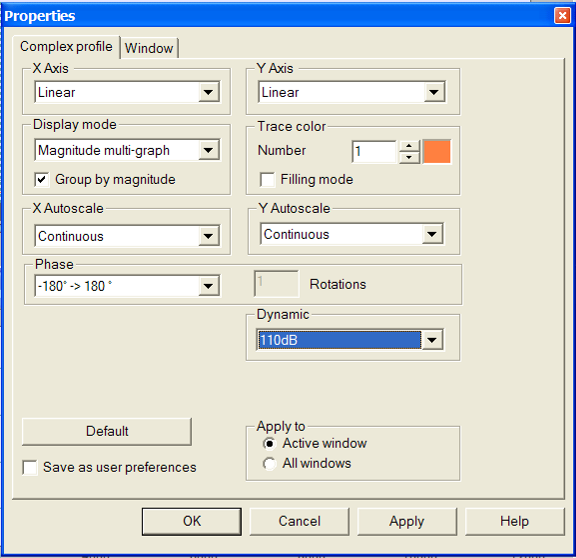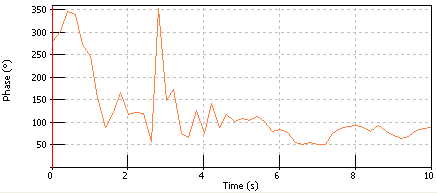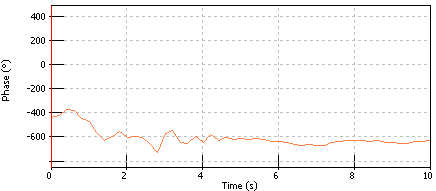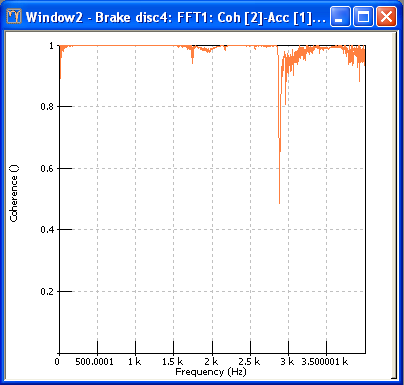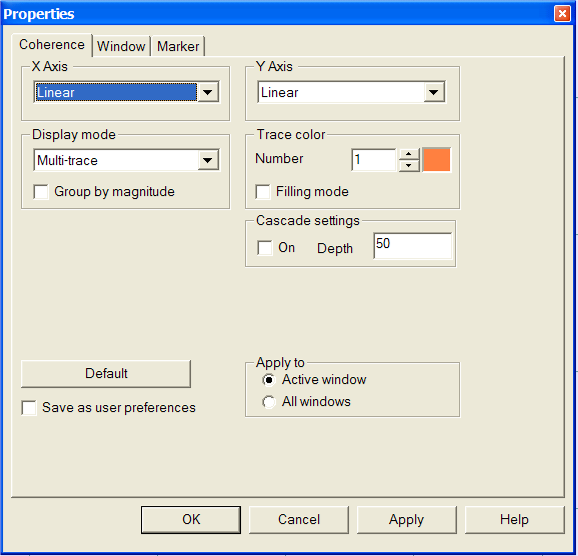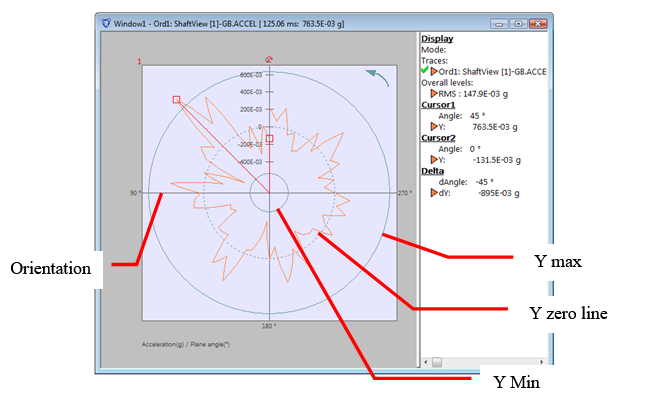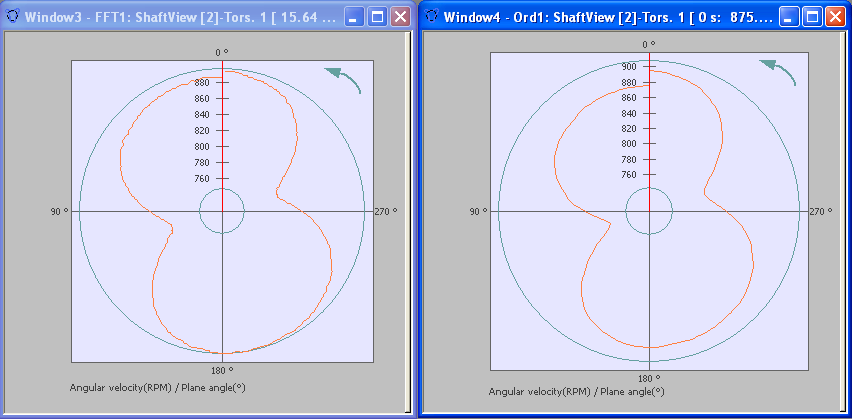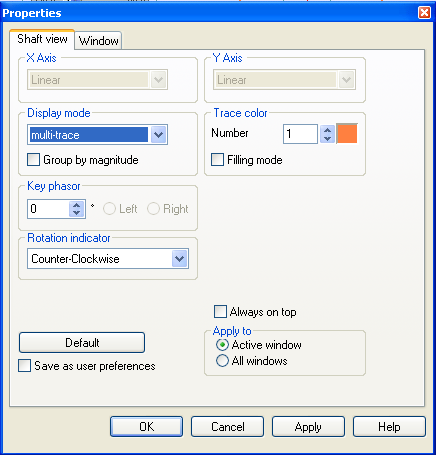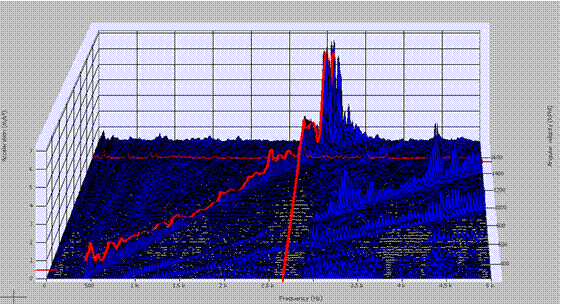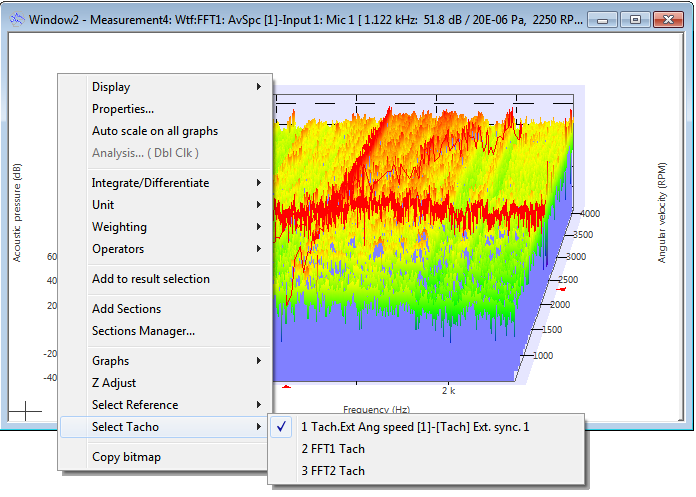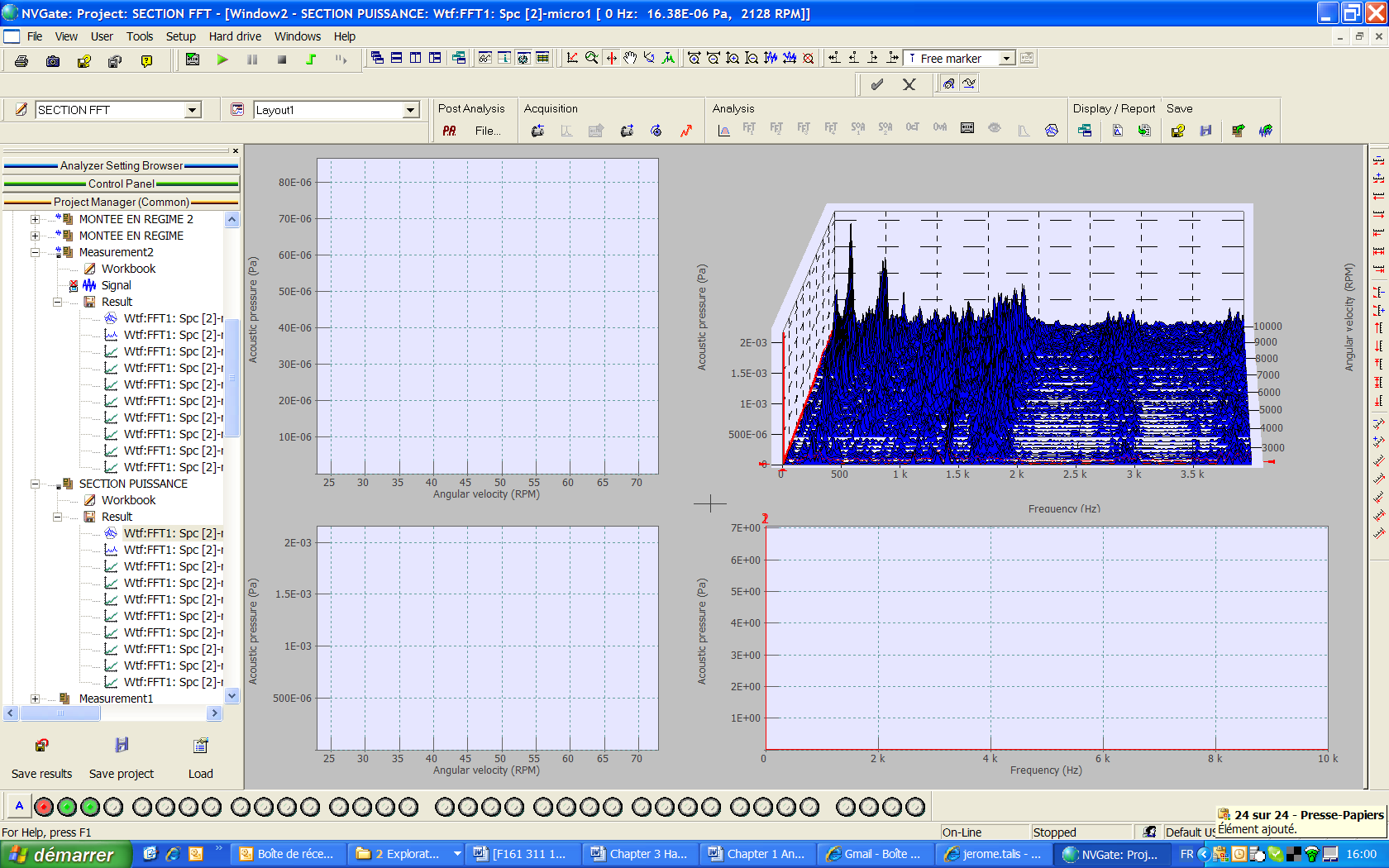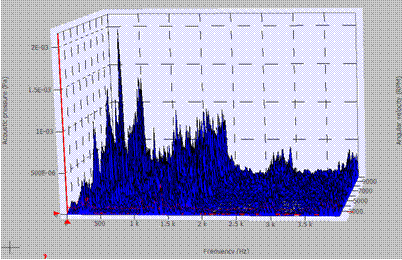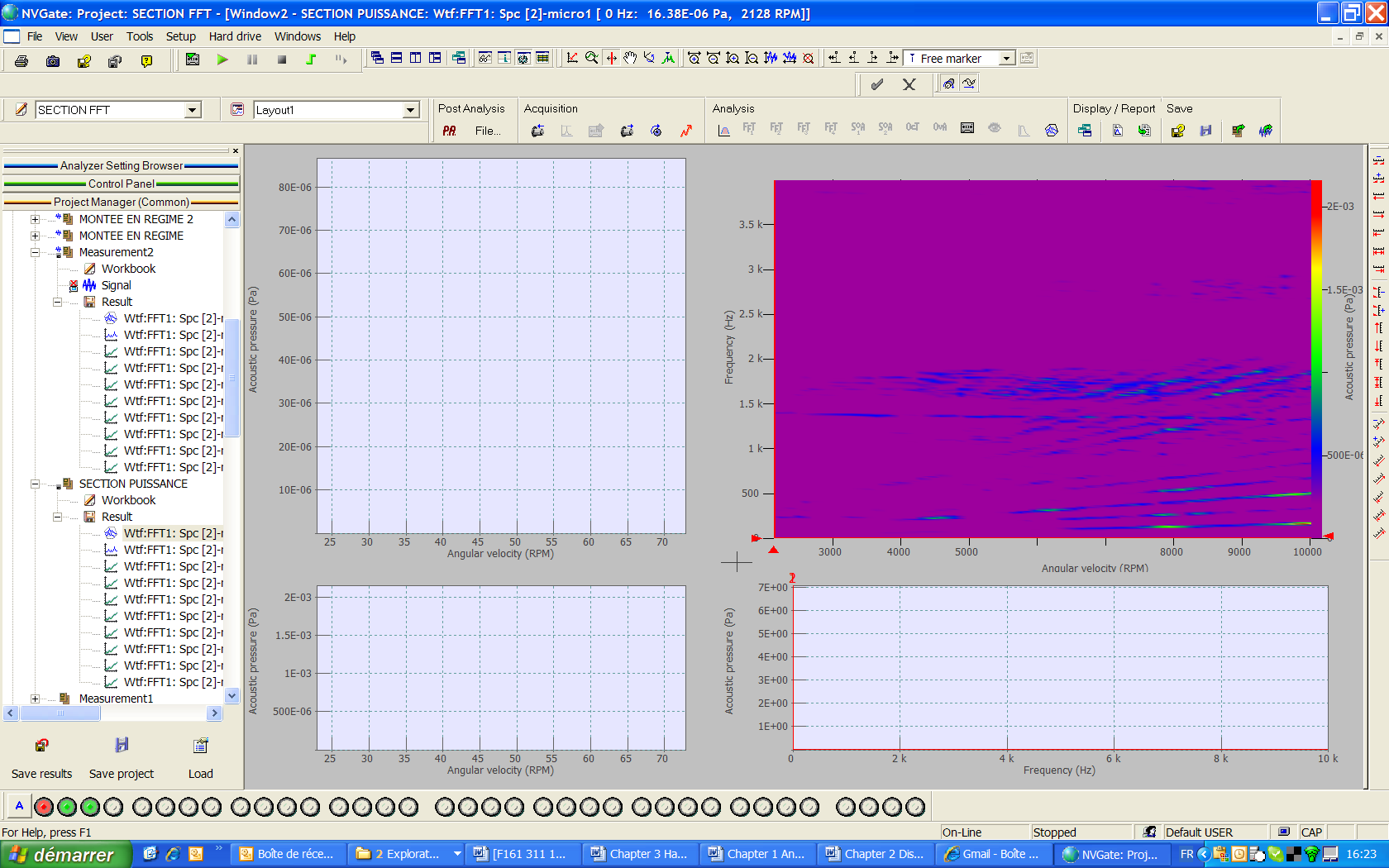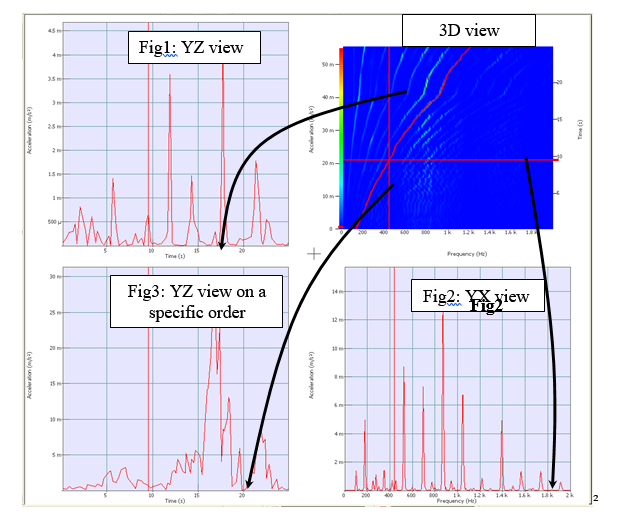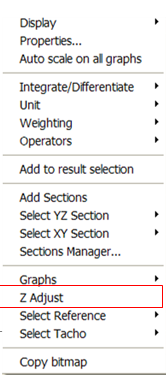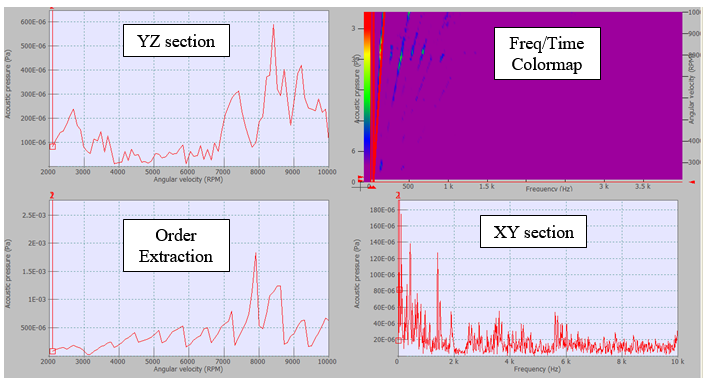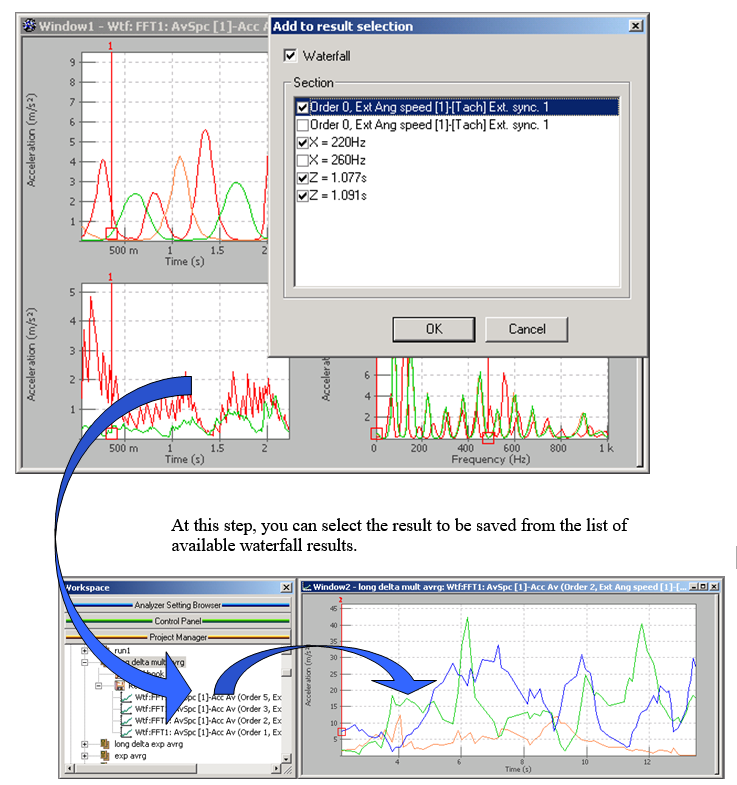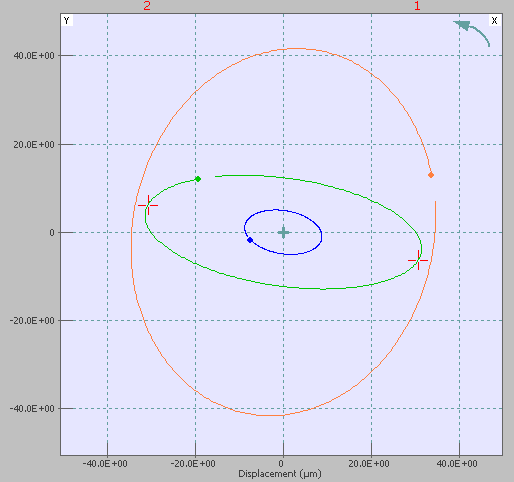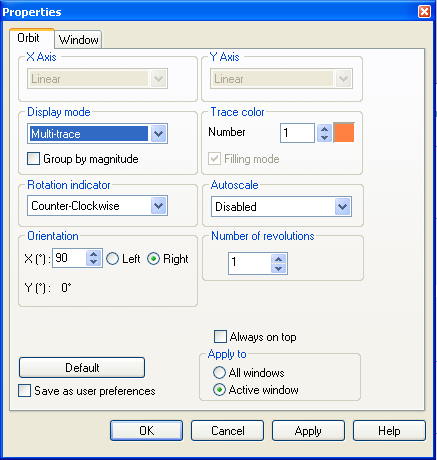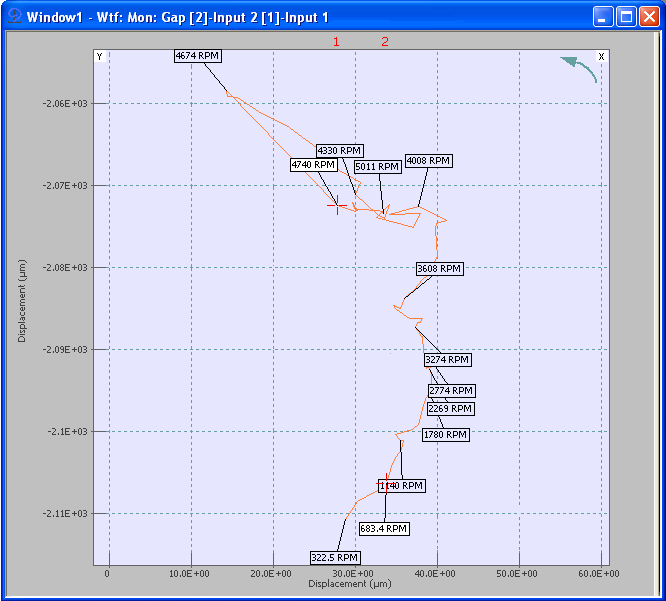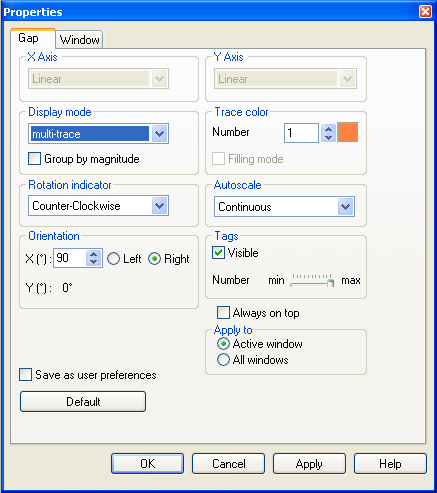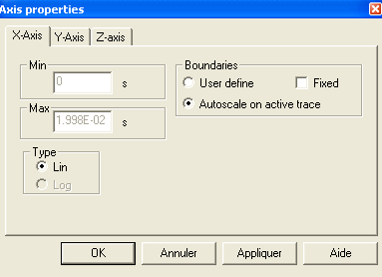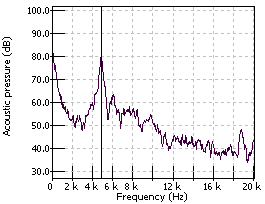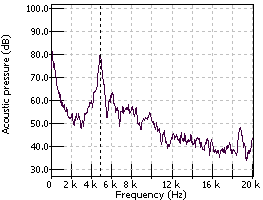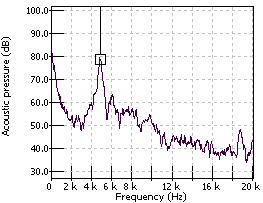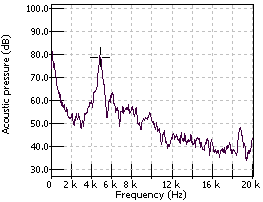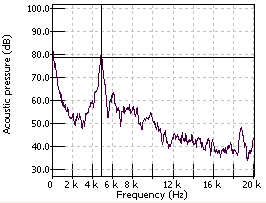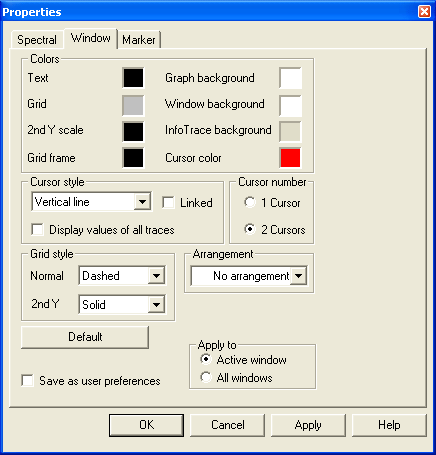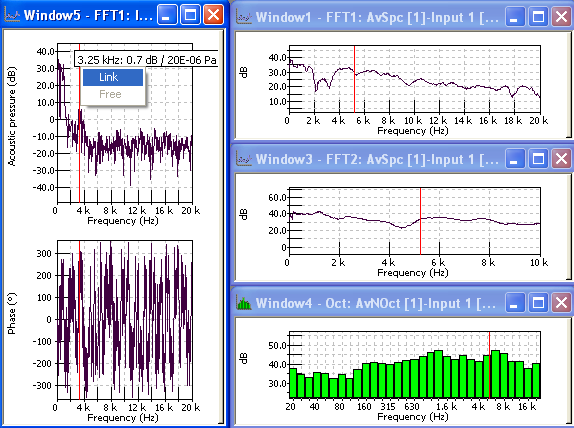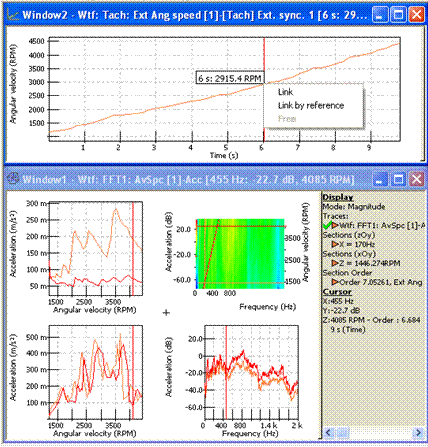NVGate Display
DISPLAY, GRAPHS & TRACES
Introduction
This section explains all the functions and information you can find in the graphs, windows, infotrace. The Display chapter also contains the information relative to the scales, graphic modes, display modes and the contextual menus.
Add/remove
Allows to display the measurement results of the active plug-in analyzers.
You can display the Add/Remove window from the Display tab.
The maximum number of traces, windows and layout available are:
- 32 Traces per Window
- 32 Windows per Layout
- 16 Layouts per project.
Display Window
The windows allow to display signal traces. They can contain several traces in the same graph (multi-trace display) or several graphs (multi-graph display). The windows can display 1D graphs (viewmeter, RPM monitoring), 2D graphs (profiles, signal recording) or 3D graphs such as Waterfall display.
Areas (infotrace, graph, scale)
All the window areas described below are right clickable so the user can choose the active trace, apply an operator or change the scales.
Infotrace
Displays information about the graph:
- Graph mode: magnitude, real...
- List of traces with their states: available or not / displayed in all areas or not / not displayed. You can move into the infotrace to select a specified trace and to follow cursor’s value of this trace. Memorized traces are also displayed in the list (Memx)
- Overall levels: Displays the RMS level in 2D windows containing spectra or time signals.
- Cursor information: x, y, order, dx, dy if available
- Marker arrays
Using keyboard arrows, you can select the active trace in the infotrace.
Traces names
The trace names indicate accurately what signal is displayed. A trace label consists on:
| Item | Indicates | example |
| File | Trace origin when it does not come from current analysis | Measurement A |
| Source | Trace origin when it does not come directly from a plug-in | Wtf, Mem02, Oper |
| Plug-in | The plug-who calculate the trace | FFT 1, OCT |
| Results type | The type of result in the plug-in | AcgSpct, Coh, Trigger block |
| Channel | The channel in the plug-in | [3] |
| Label | The input Label | Acc. top |
| Section | The section in the Waterfall | Z= 2500 RPM, X=375 RPM |
| Unit/Weighting | Applied alteration | Pk-Pk, PSD, (A) |
| Time Date | Of the result | 15:50:14 03/10/15 |
In order to simplify the trace identifications in applications that manage many measurement points (structural dynamics, Roving impact hammer) the content of the front-end identification settings are inserted in the trace labels.
The trace labels display the Component, Node and Direction when the corresponding setting is different from its default value:
- Component = None
- Node = 0
- Direction = Scalar
This applies individually, setting by setting and is independent for each channel.
Graph
Displays computed traces. It can be multi-trace or multi-graph.
Scale
Displays the magnitude and the grid of the graph
Pointer type
The pointer type is selected from the Measurement Tab./ Graphs group
Scale scrolling
Displayed when scale mode is selected and when the cursor is on a scale area. See cursor toolbar for details.
Zoom
Displayed when the magnifying tool is selected: Used to select a rectangle in a graphic area, or to zoom in with a by left clicking and dragging.
Cursor
Displayed when cursor mode is selected: Used to move the cursor by left clicking and dragging.
Move
Displayed when ’move mode’ is selected. Used to change x and y scale boundaries by left clicking and dragging.
Rotation
Displayed when the rotation tool is selected: Used to rotate a 3D graph.
Marker
Used to modify the marker position and properties.
Apply any action to the displayed traces and/or graphs by using the contextual menus on the selected area.
Customize
From the Infotrace, right click and select Customize.
This dialog box is used to select the information to be displayed in the infotrace (cursor coordinates, marker values…).
All checked items are displayed, unchecked items are not displayed.
- Select All: Selects all items
- Unselect All: Unselects all items
- Ok: Applies the changes and closes the dialog box.
- Cancel: ignores the changes and closes the dialog box.
Auto width
Sets the Infotrace area width to the width of the largest element currently displayed.
Copy marker table
Copies the marker table content to the clipboard in Excel format, in order to paste it in Excel. Each column/line of the table becomes a column/line in the Excel sheet.
See the "Copy marker" topic p 101 for more details about the marker table copy.
Close
Hides the Infotrace area.
X zoom
All of these functions are available if there is no active X automatic autoscale.
- Zoom in: Zoom in on the horizontal scale by placing the cursor position in the center.
If the center is at the minimum value, you may not zoom. You may zoom if the X scale width is greater than the active signal precision in X.
- Zoom out: Zoom out from the horizontal scale by placing the cursor position in the center.
If the center is at the minimum value, you may not zoom. You may zoom if Z min and max values are included in the min and max value gap defined by the active signal of the window. Full width.
Restores the X min and max values defined by the active signal of the window.
- Full width: Restores the Z min and max values defined by the active signal of the window.
- Auto-scale: Set min and max values of the X scale to the X min and max values of the active signal for the "On active" item and to the X min and max values of all signals of the window for "On all" item. A margin is added to these values to facilitate visibility. The X width is always more than X active signal precision.
Y zoom
- Zoom in: Used to zoom in on the vertical scale. You may zoom in if the scale width is greater than the active signal precision in Y.
- Zoom out: Used to zoom out from the vertical scale. You may zoom in if min and max values are included in Y min and max value gap defined by the active signal of the window. Full width:
Restores the Y min and max values defined by the active signal of the window.
- Full width: Restores the Z min and max values defined by the active signal of the window.
- Auto-scale: Sets min and max values of the Y scale to the Y min and max values of the active signal for the "On active" item and to the min and max values of all signals of the window for "On all" item. A margin is added to these values to facilitate visibility. The Y width is always more than Y active signal precision.
Z zoom
All of these functions are available if there is no active X automatic autoscale.
- Zoom in: Used to zoom in on the Z scale. You may zoom if the scale width is greater than the active signal precision in Z.
- Zoom out: Used to zoom out from the Z scale. You may zoom if min and max values are included in Z min and max value gap defined by the active signal of the window.
- Full width: Restores the Z min and max values defined by the active signal of the window.
- Auto-scale: Sets min and max values of the Z scale to the Z min and max values of the active signal. A margin is added to these values to facilitate visibility. The Y width is always greater than Y active signal precision.
X scale
Changes X scale type of the area to the selected type. Available types (according to the kind of the area) are:
- Linear
- Logarithmic
Y scale
Changes Y scale type of the area to the selected type. Available types (according to the kinds of the area and the window) are:
- Linear
- Logarithmic
- DB
Z scale
Changes Z scale type of the area to the selected type. Available types (according to the kinds of the area and the window) are:
- Linear
- Logarithmic
- dB
D view
There are 4 different views only available in 3D Waterfall areas..
1. 3D isometric
2. 3D perspective:
3. Freq/Time Colormap:
4. Time/Freq Colormap:
The 3D aspect can be swapped any time using the Display/Graps tab and 3D group
User marker manager
This dialog is only available for the Monitoring and Compressed windows. It contains the list of all record markers of the record signal opened. In the monitoring window, each record marker comment can be modified. In the compressed window, comments cannot be modified.
Reset Min & Max
Restores min and max values for the selected scale
Display
In each window, several display modes are available, depending on the graph type.
| Graph type | Display mode |
| Time signal | Multi-trace Multi-graph Time multi-trace 3D |
| Spectral | Magnitude Phase Real part Imaginary part Magnitude/Phase Real/Imaginary Polar Real part 3D Imaginary part 3D Magnitude 3D Phase 3D Real part multi-graph Imaginary part multi-graph Magnitude multi-graph Phase multi-graph Merged magnitude/phase |
| Nth Octave | Multi-trace Multi-graph |
| Viewmeter/Monitoring | Continuous Viewmeter Brick Digital Digital magnitude & phase |
| Waterfall | Magnitude Phase Real part Imaginary part |
| Monitoring/Compressed signal | Multi-graph (Only one mode available) |
| Profile | Multi-trace Multi-graph |
| Complex profile | Magnitude Phase Real part Imaginary part Magnitude/Phase Real/Imaginary Real part multi-graph Imaginary part multi-graph Magnitude multi-graph Phase multi-graph Merged magnitude/phase |
| Lissajoux | Multi-trace (Only one mode available) |
| Constant Band Tracking | Magnitude Phase Real part Imaginary part Magnitude/Phase Real/Imaginary Real part multi-graph Imaginary part multi-graph Magnitude multi-graph Phase multi-graph Merged magnitude/phase |
- Multi-trace: This mode displays all window traces of the same type in one graph. In several window types, two multi-trace graphs are displayed in the same window: for example, one for the Real part and one for the imaginary part. In this mode, a magnitude gathering mode can be activated in the set preferences window: this mode displays signals by creating one area for each Y magnitude included in the window. If two or more signals have the same Y magnitude, they will be displayed in the same area.
- Multi-graph: This mode displays one graph per trace in the window.
- Multi-trace 3D: This mode displays all traces in the same 3D graph.
- Real part: This mode displays the real part of the signal. It can be displayed in multi-trace, multi graph, or multi-trace 3D, depending on the graph type.
- Imaginary part: This mode displays the imaginary part of the signal. It can be displayed in multi-trace, multi graph, or multi-trace 3D, depending on the graph type.
- Magnitude: This mode displays the magnitude of the signal. It can be displayed in multi-trace, multi graph, or multi-trace 3D, depending on the graph type.
- Phase: This mode displays the phase of the signal. It can be displayed in multi-trace, multi graph, or multi-trace 3D, depending on the graph type.
- Merged magnitude/phase: This mode displays the magnitude and the phase of the signal in the same area. This is a multi-trace mode. The module scale is on the left of the graph and the phase scale is on the right.
Properties
See "Graph type" topic p 37.
- Always on top: the window will be on top
- Default: reset the all the settings to the default settings
- Apply to: applies the settings either to All windows or just for the Active window
- Save as user preferences: save the properties settings
Active trace
Select the active trace of the window. When the signal changes, the Y scale is updated to the Y magnitude of the signal. Only signals with the same Y magnitude as the active signal are displayed. The others are displayed as unavailable in the info-trace.
The color of the cursor corresponds with the trace’s color; you can select in the infotrace the active trace and its linked cursor using arrays of the keyboard.
Remove trace
Removes selected trace from the window. If this trace is the active one, the active signal is changed. A trace can be removed using ’Ctrl suppr’.
Memorize trace
Memorizes the active trace of the active window at any time (independently from Run and Stop event).
The memorized trace is named Memx: active trace name. There’s an incrementation of the memorized traces id (x). You can save the memorized traces by adding it to the result selection.
Note: you can memorize an active trace by using the insert button of the keyboard.
Clear memory
Clear all memorized traces. You can remove specific memorized traces with the ’Remove trace’ command.
AutoMemorize
’AutoMemorize’ traces consists in memorizing traces on the stop event. Select the graph to be memorized.
By using an operator on an active trace and his associated memorized traces is available by right-clicking on the graphs and selecting ’operators’. This operator will be automatically updated if a memorized trace is added or deleted (see also operators).
During a multi-run, the average on automatic memorized trace is done automatically for each run, and the average trace is automatically updated.
Auto scale Y on all
Sets min and max values of the Y scale to the Y min and max values of all signals displayed in the graph. A margin is added to these values to facilitate visibility. The Y width is always more than Y active signal precision.
Cascade view
Present the current active trace in a cascade view of the last 50 (default value) recovered results.
This is dedicated for monitoring used, this is not a waterfall (acquisition mode in real-time). The Z-axis represents the number of slices independently from any reference such as time or RPM evolution.
This function is available only for 2D spectra and trigger blocks.
Warning: if you are in manual trigger, or if there is an absence in the time, you won’t be able to notice it with the cascade view. In the following example, a pause has been made during the measurement; on the waterfall 3Dview (with time for reference) it is possible to see this pause. In the cascade view the pause won’t be noticed (number of block for reference).
Integrate/Differentiate
These commands are available only for results with an X-Axis that represents frequency lines. The operations are performed in the spectral domain.
- Normal: No operation is performed on the data
- dt: The result is integrated, so that acceleration becomes velocity. The formula used is:
- dt²: The result is integrated twice, so that acceleration becomes displacement. The formula used is:
- dx/dt: The result is derived, so that velocity becomes acceleration. The formula used is:
val_dx/dt = val
(j()
- dx/dt²: The result is derived twice, so that displacement becomes acceleration. The formula used is:
val_dx/dt2 = val
(j()²
Unit
These commands are available only for results with an X-Axis that represents frequencies. The operations are performed in the spectral domain
- RMS: Provides the RMS (EU) value. This is the default unit.
- Peak: It is based on a sine signal, and therefore equal to 1.414 times the RMS value.
- Peak-Peak: It is based on a sine signal, and therefore equal to 2.828 times RMS value.
- EU²: Means Square value.
- PSD (EU²/Hz): Calculates the Power Spectral Density of the result. The formula used is:
Where ENBW is the Equivalent Noise Band Width that takes into account the weighting windows (1 for Rectangular, 1.5 for Hanning, 1.36 for Hamming, 3.77 for Flat top) and val the RMS value.
- ESD (EU²/Hz²): Calculates the Energy Spectral Density of the result. The formula used is:
Where ENBW is the Equivalent Noise Band Width that takes into account the weighting windows (1 for Rectangular, 1.5 for Hanning, 1.36 for Hamming, 3.77 for Flat top) and val the RMS value.
- RMS PSD (EU/Hz1/2): Calculates the RMS Power Spectral Density of the result. The formula used is:
Where ENBW is the Equivalent Noise Band Width that takes into account the weighting windows (1 for Rectangular, 1.5 for Hanning, 1.36 for Hamming, 3.77 for Flat top) and val the RMS value.
Weighting
These commands are available only for results with an X-Axis that represents frequencies. The operations are performed in the spectral domain
- None: No weighting is applied.
- A Weighting: Selects the "A" weighting
- More: Used to select specialized weighting
See more details about Weightings in chapter "Appendix 2, Weighting Windows and Filters".
Operators
Operators are used to perform calculations using various results. All kind of operators (Arithmetic average, Quadratic average, Linear comparison or dB comparison) is available for any type of results
- Arithmetic average: This dialog box is designed to create a new result which is the arithmetic average of several results. This average can be calculated only for results that are in the same window. They must also have the same x-Axis definition.
The formula of the calculated result is:
Average_Result = Q
(C1
Result_1 + C2
Result_2 + ... + Cn
Result_n)
The default values of C1, C2...Cn are 1 and the default value of Q is (C1+C2+...+Cn)/n, but all these coefficients can be modified.
To set the C_i coefficient, fill in the "Coef" value and then add one or several results with the button
.
To set the Q coefficient, add up all results, check the box below "Operation result", and enter the value.
- Quadratic average: This dialog box is designed to create a new result, which is the quadratic average of several results. This average can be calculated only for results that are in the same window. They must also have the same x-Axis definition.
The formula of the calculated result is:
Average_Result = Q
[(C1
Result_1² + C2
Result_2² + ... + Cn
Result_n²)]½
The default values of C1, C2...Cn are 1 and the default value of Q is 1, but all these coefficients can be modified.
To set the C_i coefficient, fill in the "Coef" value and then add one or several results with the button
.
To set the Q coefficient, add up all your result, check the box below "Operation result", and enter the value.
- Linear comparison: This dialog box is designed to create a new result, which is the comparison of 2 results. This operation can be calculated only for results that are in the same window. They must also have the same x-Axis definition.
The formula of the calculated result is:
Comp_Result = Q
(Result_1-Result_2)
The default value of Q is 1, but all of these coefficients can be modified.
- dB comparison: This dialog box is designed to create a new result, which is the comparison of two results. The comparison is made so that the result shows the difference between the two results in dB. It corresponds to the calculation of the ratio between the two results. This operation can be performed only on results that are in the same window. They must also have the same x-Axis definition.
The formula of the calculated result is:
Comp_Result = Q
(Result_1/Result_2)
The default value of Q is 1, but all of these coefficients can be modified.
Add to Result selection
This command adds all the results displayed in the window to the list of results that must be saved in a measurement. If the result is already on the list, it is not added. Some results displayed cannot be saved (Instant trigger of the front end, profile of a DC input).
Copy graph(s)
This command copies the active graph in the format ’wmf’, this command is not available for 3D Waterfall.
Copy bitmap
This command copies graph in the format ’.bmp’
Copy data
This command copies data in order to export them in Excel. This will export all point’s values from the active graph. NVGate export values with a point as separator and in engineer mode. This command is available for all spectra and profiles (even waterfall profiles).
If the graph is displayed with complex values, then the ’copy data’ command allows to export phase and module values.
Example:
- Natural values:
Values displayed are values from the Active trace:
- Complex values:
For complex values the ’Copy data’ will displayed phase and module values.
Copy to Mask
Adds the result to the project template results. This result is then available for editing and use as a template.
Add Alarm
Dialog box to create an alarm. An alarm compares a dynamic signal with a template result. The result of the comparison can be used in the macro to perform certain tests.
To make this option available, a result template must be added to the window (using drag & drop for example).
Go to the "Chapter 5: Tools" to see more details about the Result template.
To create an alarm, select a result from the top list, a template from the bottom list and click the Add button. The list on the right displays a list of the existing alarms.
- Add section: Creates a new section at the current position of the cursor. The extraction section is created only if a tach has been selected in the Waterfall.
- Select YZ section: Selects the active trace in the YZ graph. Useful to get the value of the cursor for this section
- Select XY section: Selects the active trace in the XY graph. Useful to get the value of the cursor for this section
- Select extraction section: Selects the active trace in the extraction graph. Useful to get the value of the cursor for this section
- Section manager: This dialog box is used to create and modify sections.
To modify a section, select the desired type and the desired section then modify the Section properties and click "Apply".
To create a new section, Select the type, set the desired properties and click "Add"
To remove a section, select the desired type and the desired section, then click "Remove".
- Section properties: The XPos, ZPos, Freq or Order defines the position of the section in the Waterfall.
When the "Advanced" box is checked, it defines the center of the band.
The width is used when the "Advanced" box is checked. It defines the bandwidth.
The advanced sections are:
| Type | Sections | Type of result | Description |
| Power | YZ, Order and Frequency extraction sections | Frequency, order and octave spectra | Calculates the power within the band |
| Peak | YZ, Order and Frequency extraction sections | Frequency, order and octave spectra | Detects the highest value |
| RMS | YZ sections | Triggered and resampled block | Calculates the RMS value within the band |
| Average | YZ sections | Triggered and resampled block | Calculates the average value within the band |
| Min | YZ sections | Triggered and resampled block | Detects the minimum value within the band |
| Max | YZ sections | Triggered and resampled block | Detects the maximum value within the band |
- Z-Operator:
This Operator is available on XY extraction view and 3 operators are available: Min, Max and Arithmetic Average.
- Order Extraction:
This Operator take data spectrum by spectrum, for each spectrum there is a determination of the max value and of the corresponding order.
Using this operator it is possible to detect on which orders it is useful to work.
Note: The Max Order cannot be saved in result (not available in the ’Add to result selection’).
- View: Displays all the views or only one of the three or four available views (sections, 3D)
- Z auto scale: Adjusts the Z-scale to the current range of the selected reference
- Select reference: Reference used for the Z-Axis
- Select tach: Selection of the tach that is used for the order or frequency extraction
- Add to result selection: Check the Waterfall box to add the Waterfall to the result selection.
Check the section that must be added to the result selection. These sections will be saved as individual results (spectra, trigger blocks...)
The orientation of the 3D view of the waterfall can be modified by using the rotation button
.
A threshold is available on a waterfall by pressing the ’y’ button (or ’ctrl y’ for more precision).
Graph type
Time
Time graphs display time real signals.
Source signals (plug-in/process)
The following results may be displayed as time graphs:
- Front-end: Signal.
- Monitor: Triggered block.
- FFT x: Triggered block, weighted block.
- SOA x: Triggered block, weighted block.
Properties
- X-Axis
- Linear: uses linear scale for X-axis units.
- Y-Axis
- Linear: uses linear scale for Y-axis units.
- Logarithmic: uses logarithmic scale for Y-axis units.
- Display mode
- Multi-graph: overlays all traces using one graph per trace on the same window.
- Multi-trace: overlays all traces in one graph.
- Multi-trace 3D: overlays all traces in one 3D graph.
- Magnitude gathering: if this mode is activated and when a multi-trace mode is selected, an area is created for each different Y magnitude: all the signals with the same Y magnitude are in the same area. If there is only one different Y magnitude, all the signals are in the same area.
- Trace color
- Number: selects the trace number for color modification.
- Color box: click on this box to modify the color of the selected trace.
- Filling mode: if selected, all the curves of the windows are filled from:
- The bottom of the area if Y scale is a dB one or Logarithmic one
- The 0 value if the Y scale is linear.
Spectral
Spectral graphs display narrow band (complex) spectra.
Source Signals
The following results may be displayed as spectral graphs:
- Monitor: Inst. spectrum, Avg spectrum.
- FFT x: Inst. spectrum, Avg spectrum, Inst cross-spectrum, Avg cross-spectrum, FRF H1, FRF H2, spectrum.
- Sync. order x: Ord. inst. spectrum, Ord. avg. spectrum, Ord. spectrum.
Properties
- X Axis
- Linear: uses linear scale for X-axis units.
- Logarithmic: uses logarithmic scale for X-axis units.
- Y Axis
- Linear: uses linear scale for Y-axis units.
- Logarithmic: uses logarithmic scale for Y-axis units.
- dB: uses reference dB scale for Y-axis units.
- Display mode
- Magnitude: overlays all magnitude traces on a single graph.
- Phase: overlays all phase traces on a single graph.
- Real part: overlays all real parts traces on a single graph.
- Imaginary part: overlays all imaginary part traces on a single graph.
- Magnitude/phase: overlays all magnitude traces on the upper graph and all the phase traces on the lower graph.
- Real/imaginary: overlays all magnitude traces on the upper graph and all the phase traces on the lower graph.
- Polar: overlays all complex traces on a polar graph: = magnitude, = phase.
- Real part 3D: displays all real part traces as a 3D graph arranged along the Z-axis.
- Imaginary part 3D: displays all imaginary part traces as a 3D graph arranged along the Z-axis.
- Magnitude 3D: displays all magnitude traces as a 3D graph arranged along the Z-axis.
- Phase 3D: displays all phase traces as a 3D graph arranged along the Z-axis.
- Real part multi-graph: displays all real part traces using one graph per trace in the same window.
- Imaginary part multi-graph: displays all imaginary part traces using one graph per trace in the same window.
- Magnitude multi-graph: displays all magnitude traces using one graph per trace in the same window.
- Phase multi-graph: displays all phase traces using one graph per trace in the same window.
- Phase/Magnitude: overlays all phase traces on the upper graph using 1/3 of window space and all the magnitude traces on the lower graph using 2/3 of the window.
- Merged Magnitude/Phase: displays all magnitude and phase part traces as a unique graph.
- Magnitude gathering: if this mode is activated and when a multi-trace mode is selected, an area is created for each different Y magnitude: all the signals with the same Y magnitude are in the same area. If there is only one different Y magnitude, all the signals are in the same area.
- Trace color
- Number: selects the trace number for color modification.
- Color box: click on this box to modify the color of the selected trace.
- Filling mode: if selected, all the curves of the windows are filled from:
- the bottom of the area if Y scale is a dB one or Logarithmic one
- the 0 value of the Y scale is linear.
- Dynamics
- 90 dB: resizes the Y-axis to 90 dB dynamics starting from +20 dBV.
- 110 dB: resizes the Y-axis to 110 dB dynamics starting from +20 dBV.
- 130 dB: resizes the Y-axis to 130 dB dynamics starting from +20 dBV.
- 150 dB: resizes the Y-axis to 150 dB dynamics starting from +20 dBV.
Phase
- -180° -> 180°: sets the phase graph Y-axis between –180° to +180°.
- 0 -> 360°: sets the phase graph Y-axis between 0 to +360°.
Rotations: sets the number of rotations to be displayed on the Y-axis.
Example for 5 rotations
Lissajous
Parametric graph of one triggered block with another one for reference.
Source Signals
The following results may be displayed into Lissajous graphs:
- FFT x: Lissajous.
The perimeter of the Lissajous corresponds of the FFT length’s block.
You can use filters on this kind of graph, as integration or a double integration.
Properties
- X Axis
- Linear: uses linear scale for X-axis units.
- Y Axis
- Linear: uses linear scale for Y-axis units.
- Display mode
- Multi-trace: overlays all traces on a single graph.
- Trace color
- Number: selects the trace number for color modification.
- Color box: click on this box to modify the color of the selected trace.
- Orthonormal view: if checked, the graph is displayed in an orthonormal area.
Nth octave
Displays nth octave band graph.
Source Signals
The following results may be displayed as nth octave graphs:
- Nth-Octave: 1/n octave, Avg 1/n octave.
Properties
- Y Axis
- Linear: uses linear scale for Y-axis units.
- Logarithmic: uses logarithmic scale for Y-axis units.
- dB: uses reference dB scale for Y axis units.
- Display mode
- Bar: bar representation
- Step: step representation.
- Rectangle: overlaid rectangle
- Filled: overlaid filled rectangles.
- Display mode
- Multi-trace: overlays all traces on a single graph.
- Multi-graph: one graph for each trace.
- Magnitude gathering: if this mode is activated and when a multi-trace mode is selected, an area is created for each different Y magnitude: all the signals with the same Y magnitude are in the same area. If there is only one different Y magnitude, all the signals are in the same area.
- Trace color
- Number: selects the trace number for color modification.
- Color box: click on this box to modify the color of the selected trace.
- Overall level
- Linear: if checked, the linear global level is displayed.
- Weighted: if checked and available, the weighted level is displayed.
- Frequencies
- Exact: displays exact band center frequency.
- Preferred: displays preferred frequencies, i.e rounded values for the central frequencies. Preferred frequencies are only available for octave and 1/3rd octave windows: in the octave. If this mode is selected in 12th and 24th octave windows, exact frequencies are displayed.
- Dynamics
- 90 dB: resizes the Y-axis to 90 dB dynamics starting from +20 dBV.
- 110 dB: resizes the Y-axis to 110 dB dynamics starting from +20 dBV.
- 130 dB: resizes the Y-axis to 130 dB dynamics starting from +20 dBV.
- 150 dB: resizes the Y-axis to 150 dB dynamics starting from +20 dBV.
Viewmeter
Displays scalar value graphs.
Source Signals
The following results may be displayed as nth viewmeter graphs:
- Front-end: DC.
- Monitor: DC, Max, Min, Kurtosis.
- Recorder: RMS
- FFT X: Order & Overall
- SOA X: Order & Overall
- 1/n Octave: Overall values
- Tachometer: Angular speed
Properties
This page defines the way in which the scalar results are displayed.
- Display mode: There are two types of display:
- Bar graph
- Digital display
- Y Axis
- Linear: uses linear scale for Y-axis units.
- Logarithmic: uses logarithmic scale for Y-axis units.
- dB: uses reference dB scale for Y-axis units.
- Display max, Display min: Displays the min and the max scalar value as a cursor. The color of the cursor can be freely selected. This property only applies to bar graphs.
- Display low level: Changes the color of the display when the value is below this level. The color can be freely selected.
- Display high level: Changes the color of the display when the value is higher than this level. The color can be freely selected.
- Display alarm level: Changes the color of the display when the value is higher than this level. The color can be freely selected.
- Brick height: Defines the height of the bricks for the viewmeter and brick display modes.
- Save as user preference: When this box is checked, the value is given as a percentage of the full scale, and may be applied to any graph.
Monitoring
Displays compressed signal graph during recording.
Source Signals
The following results may be displayed as nth monitoring graphs:
- Recorder: monitoring signal
Properties
- Trace color
- Number: selects the trace number for color modification.
- Color box: click on this box to modify the color of the selected trace.
- X Axis
- Absolute time: displays the time from windows format.
- Relative time: displays the duration of the record. The beginning of the record is set to 0.
- Auto: selects absolute or relative time depending on the duration of the record. For records smaller than 2s, the relative time is displayed, for others, the absolute time is chosen.
- Y Autoscale
- Continuous: the Y scale is automatically adjusted to the current min and max y values of the window traces with a margin to facilitate visibility.
- Disabled: Y autoscale is not activated.
Compressed signal
Displays compressed recorded signal graphs.
Source Signals
The following results may be displayed as nth compressed signal graphs:
- Zoomed signal
This kind of zoom can be done by ’drag & drop’ the selected zone you want to analyze.
After displaying the zoomed signal, on the recorded signal you can modify your zoom at any time. All change would be displayed automatically in the zoomed signal as soon as you modified your zoomed zone.
Properties
- Trace color
- Number: selects the trace number for color modification.
- Color box: click on this box to modify the color of the selected trace.
- X Axis
- Absolute time: displays the time from windows format.
- Relative time: displays the duration of the record. The beginning of the record is set to 0.
- Auto: selects absolute or relative time depending on the duration of the record. For records smaller than 2s, the relative time is displayed, for others, the absolute time is chosen.
Time View
Based on the previous "Compressed signal" display, the "Time view" is used for the TDA
Source Signals
The time view is an oscilloscope-like viw of the Time Domain series which scrolls the signal on a user define duration
The X axis can be either absolute (real date / time) or relative (in buffer duration). It can be changed during acquisition. The default tyoe is relative.
It’s possible to display several TDA channels in same window even if the durations are different. The windows size will be set according to the larger duration.
X zoom is not available at Time View, display is fixed to multi graph.
This window handles 3 curors:
- Main cursor where is retrieved the values displayed at infortrace
- Cursors 1-2 used for selection. The scalar values displayed in the info trace are computed according to this selection.
Scalar table may be setup to add / remove scalar that may be displayed:
Content of Scalar Table could be copy to export to another application.
Properties
- Trace color
- Number: selects the trace number for color modification.
- Color box: click on this box to modify the color of the selected trace.
- X Axis
- Absolute time: displays the time from windows format.
- Relative time: displays the duration of the record. The beginning of the record is set to 0.
- Auto: selects absolute or relative time depending on the duration of the record. For records smaller than 2s, the relative time is displayed, for others, the absolute time is chosen.
Profile
Displays scalar profile.
Source Signals
The following results may be displayed as nth compressed signal graphs:
- Monitor: DC, Max, Min, Kurtosis
Front-end: DC
- Tachometer: RPM
Properties
- X Axis
- Linear: uses linear scale for X-axis units.
- Y Axis
- Linear: uses linear scale for Y-axis units.
- Display mode
- Magnitude: overlays all magnitude traces on a single graph.
- Phase: overlays all phase traces on a single graph.
- Magnitude gathering: if this mode is activated and when a multi-trace mode is selected, an area is created for each different Y magnitude: all the signals with the same Y magnitude are in the same area. If there is only one different Y magnitude, all the signals are in the same area.
- Trace color
- Number: selects the trace number for color modification.
- Color box: click on this box to modify the color of the selected trace.
- Filling mode: if selected, all the curves of the windows are filled from:
- the bottom of the area if Y scale is dB or Logarithmic.
- the 0 value if the Y scale is linear.
- X Autoscale
- Continuous: the X scale is automatically adjusted to the current min and max x values of the window traces.
- Disabled: X autoscale is not activated.
- Y Autoscale
- Continuous: the Y scale is automatically adjusted to the current min and max y values of the window traces with a margin to facilitate visibility.
- Disabled: Y autoscale is not activated.
Complex profile
Source Signals
The following results may be displayed as complex profile graphs:
- FFT X: Order profile
- Waterfall: Order profile
- SOA X: Order profile
Properties
- X Axis
- Linear: uses linear scale for X-axis units.
- Y Axis
- Linear: uses linear scale for Y-axis units.
- Logarithmic: uses logarithmic scale for Y-axis units.
- dB: uses reference dB scale for Y axis units.
- Display mode
- Magnitude: overlays all magnitude traces on a single graph.
- Phase: overlays all phase traces on a single graph.
- Real part: overlays all real part traces on a single graph.
- Imaginary part: overlays all imaginary part traces on a single graph.
- Magnitude/phase: overlays all magnitude traces on the upper graph and all phase traces on the lower graph.
- Real/imaginary: overlays all magnitude traces on the upper graph and all phase traces on the lower graph.
- Polar: displays in polar coordinates, the phase and the amplitude on a single graph.
- Real part multi-graph: displays all real part traces using one graph per trace in the same window.
- Imaginary part multi-graph: displays all imaginary part traces using one graph per trace in the same window.
- Magnitude multi-graph: displays all magnitude traces using one graph per trace in the same window.
- Phase multi-graph: displays all phase traces using one graph per trace in the same window.
- Phase/Magnitude: overlays all phase traces on the upper graph using 1/3 of window space and all the magnitude traces on the lower graph using 2/3 of the window.
- Merged Magnitude/Phase: displays all magnitude and phase parts traces on a single graph.
- Magnitude gathering: if this mode is activated and when a multi-trace mode is selected, an area is created for each different Y magnitude: all the signals with the same Y magnitude are in the same area. If there is only one different Y magnitude, all the signals are in the same area.
- Trace color
- Number: selects the trace number for color modification.
- Color box: click on this box to modify the color of the selected trace.
- Filling mode: if selected, all the curves of the windows are filled from:
- The bottom of the area if Y scale is dB or Logarithmic.
- The 0 value if the Y scale is linear.
- Dynamics
- 90 dB: resizes the Y-axis to 90 dB dynamics starting from +20 dBV.
- 110 dB: resizes the Y-axis to 110 dB dynamics starting from +20 dBV.
- 130 dB: resizes the Y-axis to 130 dB dynamics starting from +20 dBV.
- 150 dB: resizes the Y-axis to 150 dB dynamics starting from +20 dBV.
- Phase
- -180° -> 180°: sets the phase graph Y-axis between –180° to +180°.
- 0 -> 360°: sets the phase graph Y-axis between 0 to +360°.
Rotations: sets the number of rotations to be displayed on the Y-axis.
Example for 5 rotations
- X Autoscale
- Continuous: the X scale is automatically adjusted to the current min and max x values of the window traces.
- Disabled: X autoscale is not activated.
- Y Autoscale
- Continuous: the Y scale is automatically adjusted to the current min and max y values of the window traces with a margin to facilitate visibility.
- Disabled: Y autoscale is not activated.
Coherence
Displays coherence graphs.
Source Signals
The following results may be displayed as coherence graphs:
- FFT X: Coherence
Properties
- X Axis
- Linear: uses linear scale for X-axis units.
- Y Axis
- Linear: uses linear scale for Y-axis units.
- Display mode
- Multi-graph: overlays all traces on a single graph.
- Multi-trace: displays all traces using one graph per trace in the same window.
- Time multi-trace 3D: overlays all traces on a single 3D graph.
- Magnitude gathering: if this mode is activated and when a multi-trace mode is selected, an area is created for each different Y magnitude: all the signals with the same Y magnitude are in the same area. If there is only one different Y magnitude, all the signals are in the same area.
- Trace color
- Number: selects the trace number for color modification.
- Color box: click on this box to modify the color of the selected trace.
- Filling mode: if selected, all the curves of the windows are filled from:
- the bottom of the area if Y scale is dB or Logarithmic.
- the 0 value if the Y scale is linear.
Shaft View
The shaft view or "marguerite" shows the trigger block of FFTs and SOA around one revolution. This graph includes angular cursors (with delta-angle) useful for reading the location of peaks.
Note that in order to provide a stable trace, the corresponding plug-in must be triggered by a keyphasor. This keyphasor (any edge event) being the phase reference of each revolution. In the case of synchronous order analysis, the plug-in is automatically triggered on the tach. pulses.
The shaft view shows the first entire revolution contained in the trigger block. If less than one revolution is contained in the trigger block, nothing is displayed. A tachometer must be connect to the FFT or SOA plug-in in order to show traces in the shaft view/
The rotation indicator (and the angle labels arrangement 0 to 360°) is defined by the user’s preferences or directly from the window’s properties.
The keyphasor location is also user definable: It may take place every 45° along the complete revolution.
All graphs in a window have the same rotation and keyphasor location.
Source Signals
The following results may be displayed as Triggered Shaft View graphs on condition that a tachometer is associated to the plug-in:
- FFT x: Triggered Shaft View
- SOA x: Triggered Shaft View
The following results may be displayed as Average Shaft View graphs on condition that a tachometer is associated to the plug-in and that time average is chosen:
- FFT x: Average Shaft View
- SOA x: Average Shaft View
Properties
- X Axis
- Linear: uses linear scale for X-axis units.
- Y Axis
- Linear: uses linear scale for Y-axis units.
- Display mode
- Multi-graph: overlays all traces on a single graph.
- Multi-trace: displays all traces using one graph per trace in the same window.
- Trace color
- Number: selects the trace number for color modification.
- Color box: click on this box to modify the color of the selected trace.
- Filling mode: if selected, all the curves of the windows are filled from:
- the bottom of the area if Y scale is dB or Logarithmic.
- the 0 value if the Y scale is linear.
- Key phasor
- Allows to specify the position of the key phasor by entering the shift angle in ° and the direction left or right
- Rotation indicator
- Counter-Clockwise: defines a counter-clockwise rotation
- Clockwise: defines a clockwise rotation
Waterfall graphs (2D view, 3D view, color spectrum)
Waterfall display features different type of view of the stacked results. All views are related to the same 3D space:
The Z-axis is the selected reference (RPM, time or number of slices in order of the acquisition) its range is the waterfall depth. You can change the reference for z-axis at any time. This is available for 2D and 3D view.
The Y-axis is the selected magnitude; this can be changed at any time
The X-axis is the frequency.
Tachometer centered on FFT/SOA blocks
This allows centering tachometer speed at the center of the FFT/SOA trigger block(s). It is useful with long trigger blocks (High resolution analyses) to perfectly match the actual data with the order cursor or section.
With classical tach:
The RPM is collected at the end of the analysis block
This situation leads to an offset in the waterfall calculation of the orders (cursors, sections). For a run up, as the angular speed is over evaluated, the order calculation is lower than the actual ones.
With centered tach:
The RPM is calculated as the average speed during the block duration to be synchronized with the analyzed data.
With the centered tachometer, the orders calculations match more accurately the actual orders in waterfall.
The computation of the angular speed takes in account the averaging, triggering and overlap used in the plug-in.
The centered speed is calculated as:
The RPM centering and averaging is done in the analysis plug-in prior to be connected to the waterfall. To use the centered tach simply add the said tachometer to the corresponding plug-in (FFTn or SOAn). These additional tachometers are available in the waterfall as soon as one of the result of the plug-in is added to the waterfall.
1. Add Tach to the Plug-in,
2. Add plug-in results (Spectra, orders, etc..) to the waterfall,
3. Display the waterfall
4. Select the Plug-in Tach, as a tachometer and reference
File:Display Graphs Traces 11.png
D display modes
5. 3D isometric
6. 3D perspective:
7. Freq/Time Colormap:
8. Time/Freq Colormap:
Sections
Waterfall display provides extraction of section from the 3D space
These sections are linked with cursors of the 3D view:
- Fig1: for a fixed value of the X-axis of the 3D view,
- Fig2: For a fixed value of the reference
- Fig3: for a fixed value of the order (follow the evolution of an order) or frequency for order spectra waterfall.
During the acquisition, an autoscale is available on the z-axis (reference) if ’z Adjust’ is active.
The ’Select Tacho’ mode allows tracking an order in function of the selected tachometer. The extraction order could be done in function of the selected tacho.
4 Graphs are available for the windows allowing tracking different results:
9. 3D view: you can select by right-clicking on it an isometric view, a perspective view, a freq/time colormap or a time/freq colormap (useful to track orders). The 3D view is the default view.
10. 2D views: - XY section,
- YZ section,
- Order extraction (only available if a tachometer is active).
The sections are displayed in these 2D views. The sections can be managed in the section manager window (see waterfall window in chapter2 ’Display’).
In the section manager, add section made a copy of each cursor (Frequency, Reference, Order) in all displayed windows. These memorized traces could be added to result by the ’add to result selection.
The waterfall sections can be saved as independent results (spectra, reference profiles, extracted profiles).
The selection is achieved using the "Add to result selection" entry from the waterfall window contextual menu.
After being saved, the sections became independent results, reducing the amount of saved data when you are focusing only on extracted data.
Orbit
Displays the AC dynamic motion of the center of a rotating shaft. It generates a two-dimensional image.
Source Signals
The following results may be displayed as Orbit graphs on condition that a tachometer is associated to the plug-ins:
- FFT x: Raw Orbit, Synthetized Orbit
- SOA x: Raw Orbit, Synthetized Orbit
The Raw Orbit graph displays an entire number of complete rotations contained in one block. At least one rotation is required.
The FFT should better be triggered by the Ext. Sync. channel.
If the FFT is bad configured, it is possible that no results are shown.
The Synthetized Orbit graph is calculated with the orders of two channels selected. For a couple "ChannelA, ChannelB" up to 8 Synthetized Orbits can be selected. Each orbit corresponds to an order which appears in the tracked order setting.
The display of the Synthetized Orbit is done on 360 points (1 point per degree).
Properties
- X Axis
- Linear: uses linear scale for X-axis units.
- Y Axis
- Linear: uses linear scale for Y-axis units.
- Display mode
- Multi-graph: overlays all traces on a single graph.
- Multi-trace: displays all traces using one graph per trace in the same window.
- Trace color
- Number: selects the trace number for color modification.
- Color box: click on this box to modify the color of the selected trace.
- Filling mode: if selected, all the curves of the windows are filled from:
- the bottom of the area if Y scale is dB or Logarithmic.
- the 0 value if the Y scale is linear.
- Rotation indicator
- Counter-Clockwise: defines a counter-clockwise rotation
- Clockwise: defines a clockwise rotation
- Autoscale
- Continuous: applies a continuous autoscale during the measurement
- Disabled: disable the autoscale
- Orientation
- Allows to shift X-axis and Y-axis from a defined angle to the left or to the right; X and Y are nevertheless always orthogonal.
- Number of revolutions
- Number of revolution displayed in the graph
Gap
Displays the shaft center DC position changes.
Source Signals
The following results may be displayed as Gap graphs:
- Waterfall: Gap
The Gap is available in the Waterfall for the Monitor and Time domain analyzer plug-ins and only for the DC values.
Properties
- X Axis
- Linear: uses linear scale for X-axis units.
- Y Axis
- Linear: uses linear scale for Y-axis units.
- Display mode
- Multi-graph: overlays all traces on a single graph.
- Multi-trace: displays all traces using one graph per trace in the same window.
- Trace color
- Number: selects the trace number for color modification.
- Color box: click on this box to modify the color of the selected trace.
- Filling mode: if selected, all the curves of the windows are filled from:
- the bottom of the area if Y scale is dB or Logarithmic.
- the 0 value if the Y scale is linear.
- Rotation indicator
- Counter-Clockwise: defines a counter-clockwise rotation
- Clockwise: defines a clockwise rotation
- Autoscale
- Continuous: applies a continuous autoscale during the measurement
- Disabled: disable the autoscale
- Orientation
- Allows to shift X-axis and Y-axis from a defined angle to the left or to the right; X and Y are nevertheless always orthogonal.
- Tags
- Visible: Tags are visible on the graph
- Number: defines the tags density on the plot (min or max).
Scale
This topic deals with all the X and Y graph axis properties. It is possible to change the min and max axis values for example.
Axis properties
This dialog box is used to set the axis values and behavior.
Min
Enabled only when the "User Define" type is selected. It sets the minimum value assigned to the scale.
Max
Enabled only when the "User define" type is selected. It sets the maximum value assigned to the scale.
Type
- User Define: Used to select the min and max scale values.
- Autoscale on active trace: The minimum and maximum scale values are automatically adjusted to the values of the active trace.
- Autoscale on all traces: The minimum and maximum scale values are automatically adjusted so that every trace is fully visible.
Scale type
Changes the type of scale (Linear, logarithmic or dB). Only the available types are enabled.
Enable/disable zoom
When checked, it is impossible to make any change to the scale.
Cursors
Style
Vertical line
Displays a single line.
Vertical dashed line
Displays a single dashed line.
Vertical with rectangle
A rectangle is displayed around the selected point.
Cross hair
No line is displayed but there is a target around the selected point.
Vertical + horizontal
Displays 2 lines, an horizontal and a vertical that cross the selected point.
Dual
Select 2 cursors from the window properties. That allows to compute delta values on X-axis and Y-axis.
Cursor Link
Link the cursors of different graphs that share the same unit on the X-Axis. Once linked, all the cursors move at the same time and the same position.
Link all cursors in one click
Cursors can be linked one by one to follow the same X-coordinate. It is now possible to link/un link from the cursor contextual menu.
This apply to the link ad link by reference and concern all the cursors of the current layout.
Waterfall link
Link
Link the cursor of different graph that share the same unit on the X-Axis. Once linked, all the cursor moved at the same time and the same position
Link by reference
Link the cursor of several Waterfall referring to their internal index. Enables to link cursors that are displayed in graphs that do not share the same unit
Free
Release a cursor that has been previously linked

